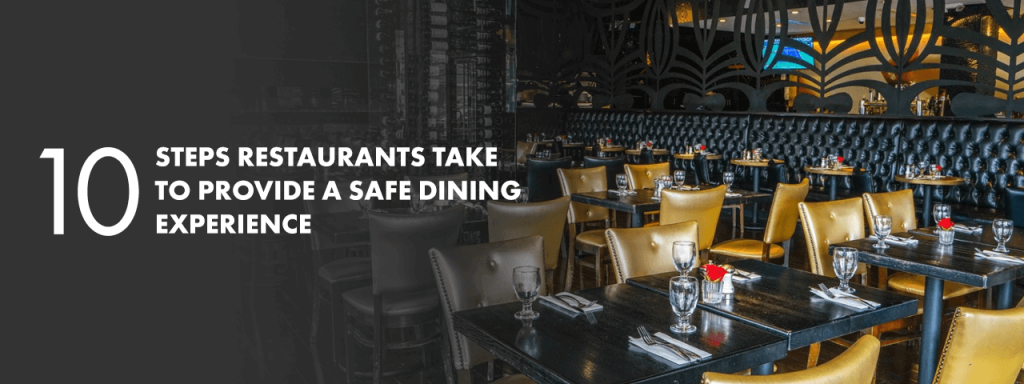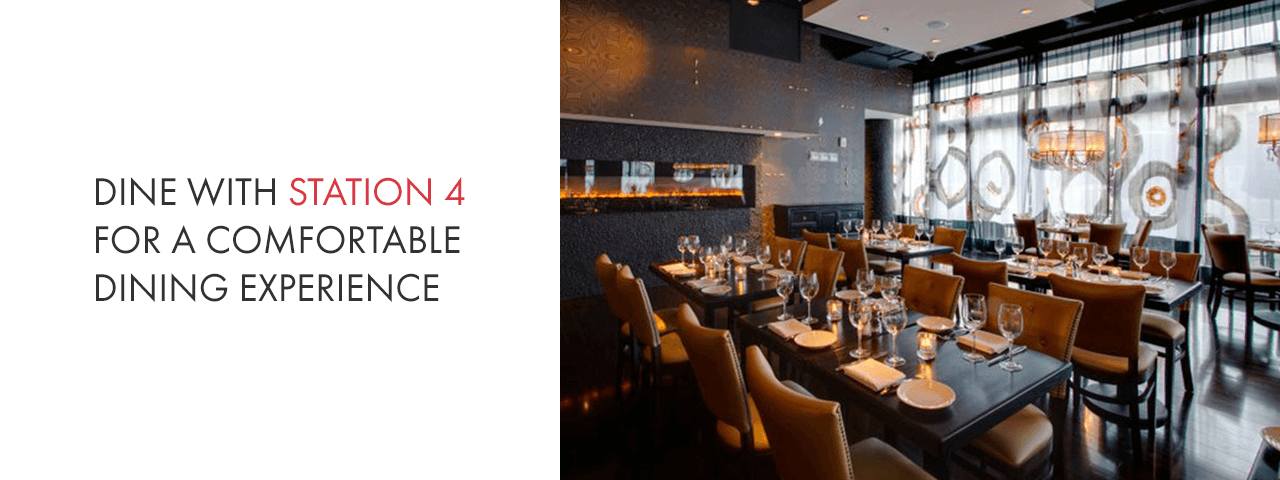
10 STEPS RESTAURANTS TAKE TO PROVIDE A SAFE DINING EXPERIENCE
Contents:
10 Best Practices for Restaurants
Dine With Station 4
The most important aspect of restaurant dining right now is health and safety. So how can restaurants ensure their guests can see their dedication to their safety and feel comfortable eating within their walls? The answer lies with taking the proper COVID-19 restaurant safety precautions and visibly adhering to local, state and federal guidelines so guests can feel free to relax and enjoy their meals.
To address any questions restaurant managers or those wondering how to eat at a restaurant safely may have, this article discusses 10 steps restaurants should take to protect the health and safety of everyone who enters their doors.
10 Best Practices for Restaurants to Provide a Safe Dining Experience
When it comes to how restaurants keep customers safe, there are certain COVID-19 restaurant practices that can help dining establishments operate as safely as possible. These are 10 of the most effective COVID-19 restaurant protocol tips to help guard the health of both guests and employees.
1. Monitor Employee Health
Routinely checking employees’ health and having them stay home when appropriate is one of the easiest ways to keep a restaurant safe and healthy. According to the guidelines from the Centers for Disease Control and Prevention (CDC), an employee who has tested positive for the coronavirus or has come in close contact with someone who has COVID-19 should remain at home.
The U.S. Food and Drug Administration (FDA) advises employers to pre-screen employees before every shift by checking their temperature and assessing any symptoms. The FDA also recommends that any employee who starts to feel sick at work should go home immediately. Restaurants can encourage sick employees to stay home without fear of negative consequences.
2. Require Face Coverings
The CDC also recommends requiring employees to wear face coverings to reduce the risk of unknowingly spreading the virus. When workers wear face coverings and gloves, it also signals to guests that the restaurant takes health and safety seriously and will take the necessary precautions to protect them. In addition to staff members, guests should be required to wear face coverings whenever they are not eating or drinking.

3. Make Indoor Dining Adjustments
Due to social distancing regulations suggesting people keep a minimum of 6 feet between each other, many restaurants have rearranged the layout of their indoor dining areas. Many restaurants have also limited their overall capacity to comply with state standards. While restaurants may need to cut down on the space they have to serve customers, they can still enhance the dine-in experience by using creative social distancing methods like dining pods or cardboard cutout placeholders.
4. Offer Outdoor Dining
With limited indoor seating space and reduced capacity, restaurants may consider offering outdoor dining options. Because the airflow and ventilation outdoors are naturally better, the risk of airborne transmission when dining outdoors is lower than when dining indoors. Restaurants should prioritize outdoor dining and expand their outdoor seating area if possible.
5. Offer Delivery, Takeout and Online Ordering Options
Dining options that are even lower risk than eating outdoors include delivery and to-go orders. Right now, takeout and delivery are the safest ways to eat out because they require little to no time inside the restaurant. Carryout is a great method for minimizing the amount of interaction between customers and restaurant workers.
Online ordering is a convenient way for customers to place their orders as well as for restaurants to receive orders. Whether through their own platform or a third party, restaurants should consider offering online ordering and delivery to boost their business.
6. Sanitize Tables and Chairs After Every Use
While a safe dining experience always includes regular sanitation measures, it is more important than ever to ensure each table and chair gets thoroughly cleaned after every use. Employers should ensure every member of their staff recognizes the importance of regularly disinfecting seating areas. The Environmental Protection Agency (EPA) has a list of approved cleaning solutions. As an extra measure of precaution, restaurants should have hand sanitizer dispensers placed throughout the building.
7. Sanitize All Shared Objects After Every Use
Along with the tables and chairs, any shared objects within the restaurant need to be properly sanitized after every use. From utensils and place settings to menus, condiments and even the pens used to sign checks, any item that a customer contacts should be disinfected before anyone else uses it.
8. Switch to the QR Code Menus
To cut down the number of shared objects and reduce contact, even more, restaurants can trade in their traditional hard copy menus for a digital QR code menu that customers can conveniently scan with their smartphones. As a more eco-friendly, paperless way to display the kitchen’s options, QR code menus may stick around even after the pandemic passes.
9. Make the Most of Signage
In addition to displaying the menu, restaurants can use signs to ensure customers are aware of any changes they may have implemented to comply with social distancing protocols. Informative signs can help restaurants manage the flow of foot traffic by guiding customers toward pickup locations and directing them where to stand to remain 6 feet apart from others. Signs can also alert customers of a restaurant’s mask policy.
10. Communicate With Customers
Restaurants should maintain clear communication with customers about their updated safety procedures to reassure their loyal diners they are still filling orders and committed to upholding health and safety standards. By posting fresh information on their websites and social media pages, restaurants can stay in touch with their customers while reducing physical contact. Restaurants can advertise everything from their latest policies to their online ordering options through their digital platforms.
Social media also allows restaurants to give customers a behind-the-scenes look at the restaurant safety procedures they’re taking so guests can feel more comfortable dining with them. Additionally, restaurants can solicit real-time feedback from guests online to find out any other adjustments they could make to create a safer and more enjoyable dining experience.

Dine With Station 4 for a Comfortable Dining Experience
If you’re looking for new creative American food from an establishment that completely complies with D.C. restaurant safety standards, Station 4 offers the perfect combination of coronavirus safety procedures and an inspired menu. Station 4 treats guests to a true foodie meal while taking extra health precautions to create a comfortable and safe dining experience.
At Station 4, we prioritize going above and beyond compliance with all current health guidelines and continue to lead in safe sanitation practices. Station 4 promises to uphold health and safety as our highest concern as we continue to serve our community great food. To minimize contact while still enjoying great food, we encourage guests to take advantage of our takeout, delivery and online ordering options.
To reserve your table or place a takeout order, contact Station 4 today.